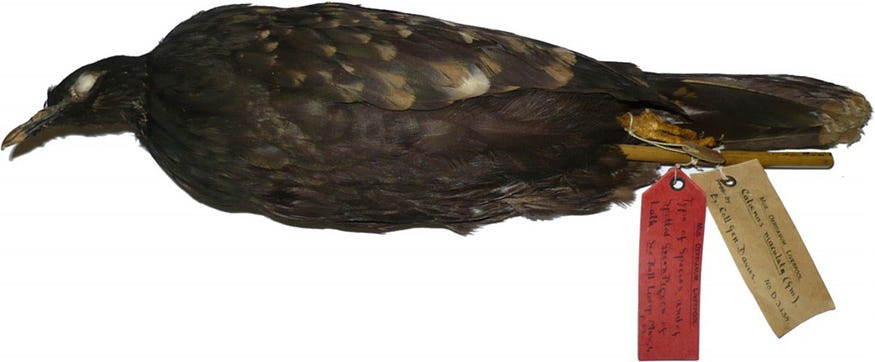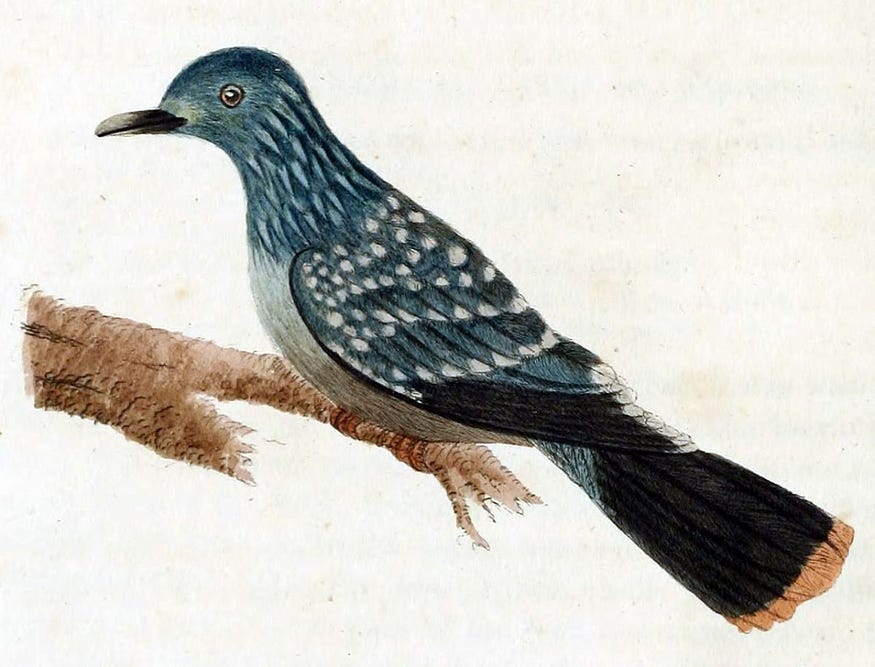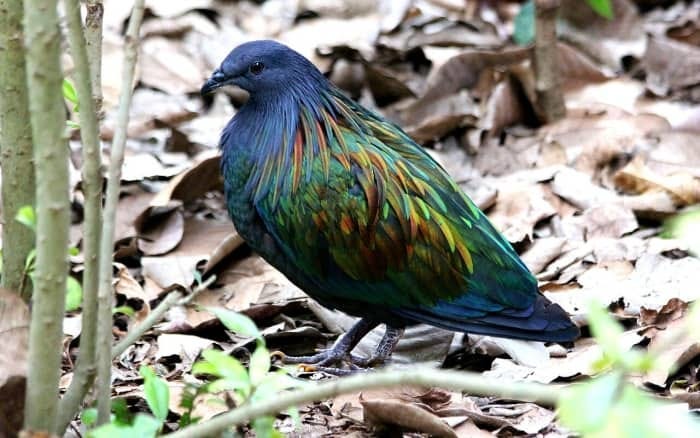
Spotted Green Pigeon
The Spotted Green Pigeon is known from only one specimen housed in the World Museum in Liverpool. The Spotted Green Pigeon, or Caloenas maculata, is a bird whose natural history remains shrouded in mystery. Even the provenance of the last remaining specimen is unknown.
So, where did this beautiful pigeon actually live? And why did it die out?
Thanks to genetic testing, scientific studies, and a book on island history, one important question has been definitively answered, and, if nothing else, an educated guess can be made about others.
This will be a brief history of an enigmatic and likely vanished species.

First Scientific Description
English ornithologist John Latham first described the spotted green pigeon in his 1783 work A General Synopsis of Birds. His knowledge of the bird was exclusively derived from seeing two specimens and a drawing of it.
The Spotted Green Pigeon’s Origin
The first of these specimens came from the collection of Sir Joseph Banks, a naturalist, botanist, and expedition scientist on explorer James Cook’s first voyage (1768–1771). During this trip, Cook and his team visited Brazil, Tahiti, and New Zealand. Although it’s still unclear where Banks’ pigeon came from, it’s reasonable to speculate that it may have originated from one of these locations.
Banks was also the main recipient of the birds found during Cook’s subsequent expeditions, providing another potential explanation for how he may have obtained his spotted green pigeon specimen. However, Banks appears to have placed little personal value on these birds, as he was known to give them away freely. Because of this, it’s impossible to tell where his specimen ended up, unfortunately.
The second specimen belonged to army officer, topographical painter and bird enthusiast Major Thomas Davies and is the one that currently resides in the World Museum.
Additionally, Latham saw a drawing of the bird that Sir Ashton Lever owned. It’s possible that Latham based his own illustration, which accompanied his description of the spotted green pigeon, on this artwork. The following is Lantham’s description:
“Length twelve inches. Bill black, tipped with pale yellow; round the eye somewhat naked; general colour of the plumage dark green and glossy: the head and neck are darker than the rest and of one plain colour; the feathers of the neck long and narrow, like the hackles of a Cock; every feather of the wings and scapulars tipped with a spot of very pale cinerous white, those of the last with ferruginous white, and even at the end: belly, thighs, and vent, dusky black: the legs are brown, and the shins covered half way with downy feathers; claws black[.]”

Possible Origins of the Spotted Green Pigeon
It was theorized, based on details about the men associated with the specimens and the bird’s resemblance to other species, that it was possibly native to an island in either the South Pacific Ocean or the Indian Ocean.
Intriguingly, Tahitian scholar Teuira Henry’s book Ancient Tahiti (published posthumously in 1928), references a bird called “titi” in the section devoted to pigeons. According to her, the titi — an onomatopoeic name supposedly based on its call — was a green and white speckled bird that once lived on Tahiti.
Henry’s history was based on the research of her grandfather, English reverend John Muggridge Orsmond, who spent the first half of the 19th-century gathering “ancient traditions of the Tahitian race, collecting them word for word as they were passed down generations by priests and storytellers.”
Sadly, his completed document vanished after being entrusted to the French. As a result, Henry had to work from her grandfather’s notes.
It was said that the Tahitians associated the titi with the mountain gods, possibly indicating that it lived in remote, high-altitude forests.

Confusion Over Classification
While no record of the spotted green pigeon’s behavior exists, scientists have surmised that it was likely arboreal based on some of its physical characteristics.
In 1789, German naturalist Johann Friedrich Gmelin gave the bird its first scientific name, Columba maculata (Latin for “spotted pigeon”).
However, there was disagreement among ornithologists on the exact classification for years. Specifically, they couldn’t seem to agree on which genus the pigeon truly belonged to, variously proposing Columba, Ptilinopus, and Caloenas as possibilities.
British zoologist Walter Rothschild even dismissed the spotted green bird as merely an anomalous Nicobar pigeon, even though more than one had been found.
Author Errol Fuller believes that this might explain why there was so little interest in the mysterious species for most of the 20th century. Fuller, when writing about the bird, gave it an alternate name: the Liverpool pigeon, after the location of the last remaining specimen.
The matter was finally put to rest after a 2014 genetic study confirmed it as a distinct species of the genus Caloenas, making it related to the extant Nicobar pigeon, as well as the extinct Rodrigues solitaire and the dodo bird.

Later Discourse on the Spotted Green Pigeon
Though we’ll likely never know for sure, some have suggested that the spotted green pigeon may have been near extinction by the time Europeans first arrived in its native habitat and that overhunting and predation by invasive species could have proved to be the final nail in the species’ coffin. However, this is purely speculation since no evidence exists for why the bird went extinct.
American paleontologist David Steadman refuted the claim that Teuira Henry had been referring to the pigeon when she wrote about the “titi,” pointing out that the word is also a term commonly used for shearwaters (a seabird) in east Polynesia. However, it’s worth noting that the bird she described does not resemble a shearwater.
While much about this striking bird remains unknown, the mysterious spotted green pigeon continues to inspire discussion and speculation.
If you would like to support my work and make a donation: Buy Me a Coffee
Want to learn more about the Spotted Green Pigeon and other extinct birds?
The mysterious Spotted Green Pigeon and its relation to the Dodo and its kindred | BMC Ecology and E
The closely related and extinct Dodo (Raphus cucullatus) and Rodrigues Solitaire (Pezophaps solitaria), both in the subfamily Raphinae, are members of a clade of morphologically very diverse pigeons.On the possible vernacular name and origin of the extinct Spotted Green Pigeon Caloenas maculata
Bulletin of the British Ornithologists’ Club contains research on all major aspects of ornithology, particularly new species, or regions incompletely known.On the possible vernacular name and origin of the extinct Spotted Green Pigeon Caloenas maculata
Bulletin of the British Ornithologists’ Club contains research on all major aspects of ornithology, particularly new species, or regions incompletely known.15 Extinct Bird Species & Possible Reasons for Their Extinction
15 extinct bird species of the world. From the Mauritius Island’s dodo to the recently extinct Bachman’s warbler.The Story of Extinct Passenger Pigeons and Their Possible “De-Extinction”
In the 19th century, passenger pigeons darkened the skies in flocks that stretched for many miles. There were billions of them.
(This article was originally published on Owlcation)



